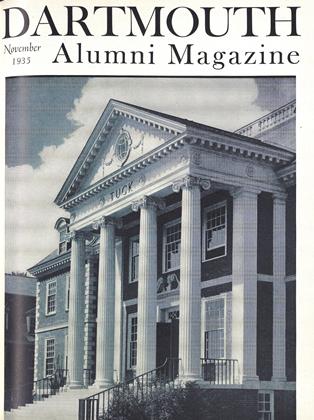A CONCERN OF older alumni during recent years has been the apparent difficulty which the younger classes find in building strong class organization and spirit. In discussions of past, present, and future College accomplishment, the theme has often been that "the good old days" bred a greater spirit of loyalty in Dartmouth than is possible with the currently large classes of 400 men or more; that the problem facing class officers in directing such large groups toward the goal of unity and interest in class and College affairs is a great one, although this interest has traditionally been characteristic of Dartmouth classes and clubs.
The record of the so-called younger classes during the last Fund campaign encourages an optimistic feeling in respect to this particular problem. In the list of the first 15 classes in order of their record of percentage of contributors, there are 4 of the younger group—1928, 1925, 1927, and 1930. The class of '28 jumped from 49% contributors last year to 90% this year and the class of '25 made an almost equally good showing by progressing from 44% to 81%. In the case of every class recently graduated an advance over last year was made in number of contributors.
There is printed below a table of Alumni Fund comparisons made for the years 1929, 1932, and 1935. For each of these years figures are presented showing the combined record of the 15 youngest classes. These 15 classes approximate in total membership one half of the alumni body. Those alumni who are seriously concerned about the poor organization of younger classes as compared to older ones will find a good deal of interesting material in this tabulation. Although 71% of men in the 15 classes contributed in '29, the actual number of contributors in '35 was 'more than 600 higher. In the face of this rather strong showing in numbers it should be pointed out that the record of the group of classes would be better if more widespread support were given to the Fund by the very youngest classes. The problem of building good organization is seldom solved until a class has been out of college for at least several years.
 View Full Issue
View Full Issue
More From This Issue
-
 Article
ArticleTHE OUTING CLUB REORGANIZES
November 1935 By Natt W. Emerson '00 -
 Class Notes
Class NotesClass of 1914
November 1935 By Edward Leech -
 Class Notes
Class NotesClass of 1911
November 1935 By Prof. Nathaniel G. Burleigh -
 Article
ArticleHANOVER BROWSING
November 1935 By Herbert F. West '22 -
 Class Notes
Class NotesClass of 1934
November 1935 By Martin J. Dwyer Jr. -
 Class Notes
Class NotesClass of 1908
November 1935 By L. W. Griswold
The Editor
-
 Article
ArticleTo Natt Emerson
December 1935 By The Editor -
 Article
ArticleThe Month
January 1936 By The Editor -
 Article
ArticleGRADUS AD PARNASSUM
April 1940 By The Editor -
 Article
ArticlePass the Bowl!
October 1940 By The Editor -
 Article
ArticleA High Objective
May 1941 By The Editor -
 Article
ArticleThe Associated Schools
April 1942 By The Editor
Article
-
 Article
ArticleAlumni Council Elections
February 1946 -
 Article
ArticleSIGNS OF AWAKENING
December 1941 By Craig Kuhn '42 -
 Article
ArticleRUGBY
MAY 1964 By DAVE ORR '57 -
 Article
ArticlePrimary Postmortem
MAY 1992 By Jonathan Douglas '92 -
 Article
ArticleThayer School
JANUARY 1965 By RUSS STEARNS '38 -
 Article
ArticleTHE DARTMOUTH CAMPAIGNS FOR:
June 1931 By W. H. Ferry '32

